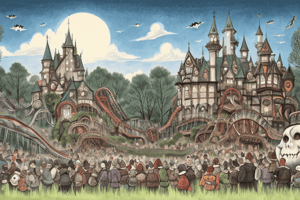Podcast
Questions and Answers
What is the prologue about?
What is the prologue about?
1980-90 war in El Salvador that resulted in 100,000 people dead, immigration to the U.S., and the rise of MS-13.
Describe the events in Chapter 1.
Describe the events in Chapter 1.
The narrator was initiated into the gang, had his first mission at 9 years old where he killed a man, and faced violence from rival gang La Calle 18.
What happened to the narrator's mother in Chapter 2?
What happened to the narrator's mother in Chapter 2?
She was shot and killed by a gang member while they were in La Calle 18 territory.
What was the father's intention in Chapter 3?
What was the father's intention in Chapter 3?
Signup and view all the answers
Who did Pedro and the narrator live with in Chapter 4?
Who did Pedro and the narrator live with in Chapter 4?
Signup and view all the answers
What significant action did the narrator take in Chapter 5?
What significant action did the narrator take in Chapter 5?
Signup and view all the answers
What role did the narrator have in Chapter 6?
What role did the narrator have in Chapter 6?
Signup and view all the answers
What was the nature of the narrator's relationship with Analía in Chapter 7?
What was the nature of the narrator's relationship with Analía in Chapter 7?
Signup and view all the answers
What choice did the narrator make in Chapter 8?
What choice did the narrator make in Chapter 8?
Signup and view all the answers
How did Pedro confront the narrator in Chapter 9?
How did Pedro confront the narrator in Chapter 9?
Signup and view all the answers
What news did Gustavo share with the narrator in Chapter 10?
What news did Gustavo share with the narrator in Chapter 10?
Signup and view all the answers
What happens in the climactic scene of Chapter 11?
What happens in the climactic scene of Chapter 11?
Signup and view all the answers
Study Notes
Prologue
- El Salvador's civil war (1980-90) resulted in approximately 100,000 deaths.
- Violence led many to emigrate to the U.S., particularly Los Angeles.
- MS-13, known as "La Mara Salvatrucha," emerged during this time.
- Government response included deportation and imprisonment of gang members.
- Over 100,000 active gang members, with 10,000 belonging specifically to MS-13.
- Membership initiation involved "jumping-in."
- Tattoos symbolize gang affiliation, experiences of loss, and identity.
- MS-13 is linked to illegal drugs and smuggling operations from Central America.
Chapter 1
- The narrator's initiation into the gang involved a murder at the age of 9.
- Experienced a brutal initiation, enduring 13 seconds of being beaten.
- Rival gang, La Calle 18, posed significant threats.
- Gang named La Mara Salvatrucha 13 formed for protection against Calle 18.
Chapter 2
- A pivotal event occurs when Pedro, aged 6, witnesses his mother's murder by gang members while shopping.
Chapter 3
- In grief, the narrator's father seeks revenge against the killer but is arrested and deported back to El Salvador.
Chapter 4
- Pedro and the narrator live with Gustavo, a family friend who was also in the same gang.
- They immigrated to the U.S. aiming for a better life, fleeing war in El Salvador, but violence persists.
Chapter 5
- At just 9 years old, the narrator's first mission requires him to use a pistol supplied by Gustavo.
- He receives a tattoo commemorating his parents after committing violence.
Chapter 6
- At 16, the narrator's role expands to collecting money from local businesses for gang protection.
- Struggles with old women who resist paying the gang, highlighting the moral complexities of his job.
Chapter 7
- The narrator meets Analía, his girlfriend, who inspires him to reconsider his gang involvement.
- Their relationship causes friction due to contrasting lifestyles; she cries upon hearing about his life.
Chapter 8
- The narrator chooses to prioritize his relationship with Analía over attending a gang meeting, signaling a shift in his values.
Chapter 9
- Tensions arise when Pedro accuses the narrator of neglecting his gang duties for Analía, reflecting internal conflicts between loyalty and love.
Chapter 10
- Pedro collects money instead of the narrator, leading to tragic news of his death from a drive-by shooting linked to Calle 18.
- Grief prompts the narrator to consider revenge, despite Analía urging him to escape the gang life.
Chapter 11
- The gang prepares for retaliation following Pedro's murder.
- Tension escalates during their mission into Calle 18 territory, where the narrator confronts Pedro's killer amidst violence.
Chapter 12
- Analía is caught in the crossfire during the retaliation, highlighting the tragic consequences of gang violence.
- The narrator cradles a seriously injured Analía, symbolizing the personal cost of his gang loyalty and the cycle of violence.
Studying That Suits You
Use AI to generate personalized quizzes and flashcards to suit your learning preferences.
Description
Explore the origins and impacts of MS-13 during El Salvador's civil war, covering the violence that led to mass emigration and the emergence of gang culture. Understand the initiation processes and the societal reactions to gang-related issues in the U.S. This quiz delves into the complex dynamics of identity, survival, and crime in this tumultuous period.




